Samsung Announces Galaxy Note5 And Galaxy S6 Edge+
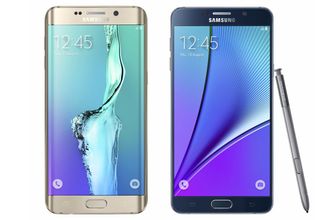
Samsung announced two new flagship phablet phones today, an update to the venerable productivity-focused Galaxy Note series—the Galaxy Note5—and a media-centric, oversized Galaxy S6 edge called the Galaxy S6 edge+ (a convoluted name that even tripped up the PR reps).
Last year's Galaxy Note 4 impressed us, earning our top Editors' Choice award. It has an excellent screen, power-user features like a removable battery and expandable storage, software that takes full advantage of the large display, and a nice-looking design that blends the best qualities of aluminum and plastic. Combined with Samsung's S Pen stylus, the Note 4 is a unique device that, together with its predecessors, helped popularize the phablet category.
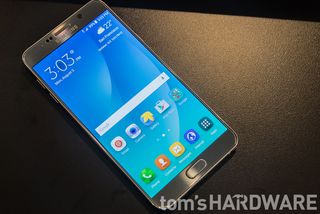
Despite this success, Samsung is pushing the Note5 in a different direction. It retains the 5.7-inch QHD (2560x1440) Super AMOLED screen from the previous Note and squeezes it into a smaller, redesigned body. Adopting the same styling and aluminum frame and glass back construction as the smaller Galaxy S6 (which we also liked a lot), the Note5 sheds its removable battery and microSD card slot. It is also the first Note phone without significantly more powerful internal hardware than its smaller predecessor.
By adopting the sleek design of the Galaxy S6, Samsung clearly believes it's time for the Note to move out of its niche towards a broader, more mainstream audience. The issue with this strategy is that what makes the Note series popular is different than what draws people to the smaller Galaxy S phones.
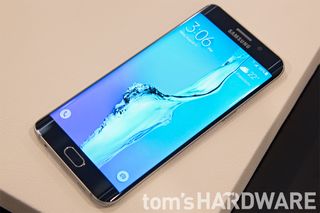
As for the Galaxy S6 edge+, it's interesting that Samsung's follow-up to the limited production Note Edge is not another Note product, but a giant Galaxy S6 edge. This means that there is no S Pen, of course. Like the Note5, the bigger edge is not much different internally than its smaller sibling, sharing the same design but using a larger 5.7-inch screen.
Samsung seems to believe there is a clear delineation between the kind of users who value a feature like the S Pen and those who appreciate the more stylish dual-curved screen of the edge. We do not see why, though, that the new Note cannot have the best of both worlds and feature the S Pen and the curved screen. It worked for the Note Edge (albeit with the curve only on one side), and Samsung would not need to promote two separate products. Perhaps Samsung's dual-phablet strategy will become clearer to us once we've been able to spend more time with the new phones.
Hardware Specifications
| Products | Samsung Galaxy S6 edge | Samsung Galaxy S6 edge+ | Samsung Galaxy Note 4 | Samsung Galaxy Note5 |
|---|---|---|---|---|
| Display | 5.1-inch SAMOLED @ 2560x1440 (577 PPI) | 5.7-inch SAMOLED @ 2560x1440 (518 PPI) | 5.7-inch SAMOLED @ 2560x1440 (515 PPI) | 5.7-inch SAMOLED @ 2560x1440 (518 PPI) |
| SoC | Samsung Exynos 7420 | Samsung Exynos 7420 | Qualcomm Snapdragon 805(APQ8084) | Samsung Exynos 7420 |
| CPU Core | ARM Cortex-A57 (4x @ 2.1GHz) + ARM Cortex-A53 (4x @ 1.5GHz) [big.LITTLE] | ARM Cortex-A57 (4x @ 2.1GHz) + ARM Cortex-A53 (4x @ 1.5GHz) [big.LITTLE] | Qualcomm Krait 450 (4x @ 2.65GHz) | ARM Cortex-A57 (4x @ 2.1GHz) + ARM Cortex-A53 (4x @ 1.5GHz) [big.LITTLE] |
| GPU Core | ARM Mali-T760MP8 @ 772MHz | ARM Mali-T760MP8 @ 772 MHz | Qualcomm Adreno 420 @ 600MHz | ARM Mali-T760MP8 @ 772MHz |
| Memory | 3GB LPDDR4 | 4GB LPDDR4 | 3GB LPDDR3 | 4GB LPDDR4 |
| Storage | 32GB, 64GB, 128GB | 32GB, 64GB | 32GB, microSD (up to 128GB) | 32GB, 64GB |
| Battery | 10.01Whr (3.85V 2600 mAh, non-removable) | 3000 mAh, non-removable | 12.4Whr (3.85V 3220mAh, removable) | 3000mAh, non-removable |
| Front Camera | 5 MP, 1/4.1" Samsung S5K4E6, 1.34μm, f1.9, 22mm, automatic HDR | 5 MP, f/1.9 | 3.7 MP, 1/5.4" Samsung S5K6D1YX, 1.12μm, f/1.9, 22mm | 5 MP, f/1.9 |
| Rear Camera | 16 MP, 1/2.6" Sony IMX240 Exmor RS or Samsung S5K2P2 ISOCELL, 1.12μm, f/1.9, 28mm, PDAF, OIS, automatic HDR, object tracking autofocus, LED flash | 16 MP, 1/2.6" Sony IMX240 Exmor RS or Samsung S5K2P2 ISOCELL, 1.12μm, f/1.9, PDAF, OIS, automatic HDR, object tracking autofocus, LED flash | 16 MP, 1/2.6" Sony IMX240 Exmor RS, 1.12μm, f/2.2, 31mm, PDAF, OIS, HDR, LED flash | 16 MP, 1/2.6" Sony IMX240 Exmor RS or Samsung S5K2P2 ISOCELL, 1.12μm, f/1.9, PDAF, OIS, automatic HDR, object tracking autofocus, LED flash |
| Connectivity | Wi-Fi 802.11a/b/g/n/ac (2x2 MIMO), Bluetooth 4.1 LE, NFC, IrLED, 4G LTE (Cat 6), microUSB 2.0 | Wi-Fi 802.11a/b/g/n/ac (2x2 MIMO), Bluetooth 4.2 LE, NFC, 4G LTE (Cat 9), microUSB 2.0 | Wi-Fi 802.11a/b/g/n/ac (2x2 MIMO), Bluetooth 4.1, NFC, IrLED, 4G LTE (Cat 4), microUSB 2.0 | Wi-Fi 802.11a/b/g/n/ac (2x2 MIMO), Bluetooth 4.2 LE, NFC, 4G LTE (Cat 9), microUSB 2.0 |
| Special Features | Multi Window, fingerprint scanner (touch), Samsung Pay, Quick Launch camera, wireless charging (WPC 1.1 & PMA 1.0), Qualcomm Quick Charge 2.0 | Multi Window, fingerprint scanner (touch), Samsung Pay, Quick Launch camera, wireless charging (WPC 1.1 & PMA 1.0), Qualcomm Quick Charge 2.0 | S Pen (stylus), Multi Window, fingerprint scanner (swipe), Qualcomm Quick Charge 2.0 | S Pen (stylus), Multi Window, fingerprint scanner (touch), Samsung Pay, Quick Launch camera, wireless charging (WPC 1.1 & PMA 1.0), Qualcomm Quick Charge 2.0 |
| OS | Android 5.1.1(TouchWiz) | Android 5.1.1(TouchWiz) | Android 5.0.1(TouchWiz) | Android 5.1.1(TouchWiz) |
| Materials | Aluminum, Glass | Aluminum, Glass | Aluminum, Plastic | Aluminum, Glass |
| Size | 142.1 x 70.1 x 7.0 mm, 132g | 154.4 x 75.8 x 6.9 mm, 153g | 153.5 x 78.6 x 8.5 mm, 176g | 153.2 x 76.1 x 7.6 mm, 171g |
Samsung's current flagship phones are nearly identical in both features and hardware. The Note5 and S6 edge+ use the same 64-bit Exynos 7420 big.LITTLE SoC (clocked at the same speeds for both the A57 and A53 cores) along with the same ARM Mali-T760MP8 GPU. Previous Notes delivered higher performance than the smaller Galaxies, but with the S6 and S6 edge already using the fastest SoC currently available, Samsung had no other options.
Stay on the Cutting Edge
Join the experts who read Tom's Hardware for the inside track on enthusiast PC tech news — and have for over 25 years. We'll send breaking news and in-depth reviews of CPUs, GPUs, AI, maker hardware and more straight to your inbox.
Despite using the same silicon, we should still see slightly better performance from these new phones over the smaller S6s. The SoC will have more thermal headroom in the bigger chassis and thus should throttle less—not that this is a big problem for the 7420 built on Samsung's 14nm FinFET process.
These newer devices also come with 4 GB of LPDDR4 RAM instead of 3 GB, giving TouchWiz more room to work and enabling better multitasking performance. The larger Galaxies also make the jump to Category 9 LTE, supporting up to 450 Mbps download and 50 Mbps upload speeds.

The 5.7-inch screens are the real showpieces of these phones, with amazing pixel density and beautiful colors. Gone are the days of oversaturated AMOLED color; these screens looked sharp and well calibrated (though perhaps with a slight blue-green tint that may simply be the result of wonky conference room lighting). We were not told if the Note5's flat display is the same panel as the Note 4's, or a newer generation panel with higher brightness and improved color accuracy.
After the disappearance of swappable batteries and expandable storage from the S6 and S6 edge, we were hoping that Samsung would recognize that there is still a group of users who value these features. Unfortunately, these capabilities are missing from both the Note5 and S6 edge+, too. Sure, the new phones are available with up to 64 GB of high-performing UFS 2.0 NAND, but microSD cards are a relatively inexpensive way of adding additional, flexible storage space. What's even more upsetting is that the smaller S6 and S6 edge come with up to 128 GB of internal storage, while the productivity- and media-focused Note5 and S6 edge+ are limited to only 64 GB—less than what's available in the iPhone 6 Plus.
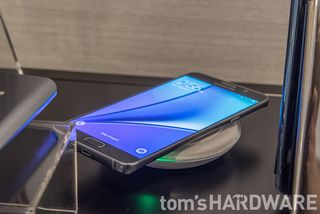
The 3,000 mAh batteries in the Note5 and S6 edge+ are an improvement over the 2,550 mAh and 2,600 mAh batteries in the Galaxy S6 and S6 edge, respectively. Despite using the same internal hardware, however, the larger screens will certainly use more power, so it's hard to say if battery life will improve with the larger phones. The 3,000 mAh cells are also a bit smaller than the 3,220 mAh battery in the Note 4. Depending on workload, the Exynos 7420 should use less power than the Snapdragon 805, so battery life may actually be similar. And if the Note5 does use a more efficient, newer generation screen, it might even get better battery life than the Note 4 despite having a smaller battery.
Without the ability to swap batteries, charging becomes even more important. Both of the new phones support fast charging along with Qi and PMA wireless charging to top up the phone during the day.
Hardware Design
There is no question that the Note5 and S6 edge+ have adopted the 2015 design language of the Galaxy S6s, for better or worse. Gone are the flat metal sides and removable plastic back of the Note 4 and Note Edge. Rather, these new large-screen devices are clad in metal and glass. While this change certainly makes for sexier, fashionable phones, it comes with the same compromise that impacted the Galaxy S6: a non-removable battery. There is also the less critical compromise of the glass back being more fragile and susceptible to fingerprints, marring its finish.

The Galaxy Note5 design is interesting in that it's almost the reverse of the S6 edge+. The front is flat while the glass back curves down on each side. The S6 edge+, meanwhile, repeats the design of the S6 edge, with the display being curved on both sides, and its back being flat. This means that both models have the same thin metal sides of the S6 edge that made it harder and less comfortable to hold onto than the flat sides of the regular S6.
Both the Note5 and S6 edge+ have a minimal amount of bezel on the sides of the screen, which helps keeps their overall size down despite their big displays. The dual-curved screen on the S6 edge+ makes the phone appear nearly bezel-less. The characteristic Galaxy home button, which doubles as a touch-based fingerprint reader (the same as on the smaller S6s), still resides below the screen.
Other than how the edges curve, the only other significant difference between the Note5 and S6 edge+ is the inclusion of the S Pen on the former. On this year's model, the stylus is spring-loaded and pops out when you push on it.

Whether you are a fan (or not) of the new design inherited from the S6, one feature that has carried over that we can surely all agree should have been fixed is the camera bump. Although it's understandable that Samsung wanted to make these new phones as slim as possible, surely on such big devices a few more millimeters of girth to hide the camera bump would have been acceptable.
The Note5 and S6 edge+ feel sturdy and stiff, despite being thinner and lighter than the Note 4. The Note5 is about the same height as the Note 4 but is noticeably narrower. When compared to the Note Edge, the S6 edge+ is taller but considerably narrower, thinner and lighter.
Samsung's odd experiments with soft-touch plastics and faux stitching always seemed out of line with its attempts to be seen as a premium brand, although plenty of questionable design decisions are still apparent in the cases intended for these phones. These range from more fake leather to cases with the most glitter-per-square inch we've seen outside of a 4th-grader's arts and crafts project.
As for colors, in the U.S. the Note5 will be available in Black Sapphire and White Pearl. The S6 edge+ comes in Black Sapphire and Gold Platinum.
Camera

The Galaxy S6 is considered to have one of the best smartphone cameras currently available, and the Note5 and S6 edge+ use the same technology. The rear camera on both is a 16MP sensor with phase detect autofocus (PDAF), optical image stabilization (OIS), and an f/1.9 lens. What we are not sure of is if the Note5 and S6 edge+ will be participating in Samsung's camera sensor lottery.
On the S6 and S6 edge, you can either get a phone with a Sony Exmor RS IMX240 sensor or a Samsung S5K2P2 ISOCELL sensor. Which sensor you get depends on when and in what factory your phone was made. Although the sensors have identical specifications on paper and the optics in front are the same no matter the sensor, we did find that the Sony produced slightly better images. Because there is no way to tell what sensor you will get before you buy the phone, we did think it was a little unfair to Galaxy S buyers that some of them got a better camera. We do hope this does not happen with the Note5 and S6 edge+.
The camera app starts up blazing fast and is quick to focus and capture. Along with the camera options found on the S6, Samsung has capitalized on a recent trend to add a unique feature: built-in live streaming. From within the camera app, you can log into YouTube and create and broadcast a live feed. The app allows you to post your YouTube URL to social media or keep the feed private and send specific invites to friends and family. It looked fast, easy to use and remarkably intuitive. The feed is accessible from any device that can navigate to a YouTube URL.
Around front, we have the same 5MP camera as found on the Galaxy S6, along with the same f/1.9 lens.
Software Enhancements

With Android M not coming out until the fall, the Note5 and S6 edge+ both run Android 5.1.1. As Samsung phones, they also use the TouchWiz UI. TouchWiz already received a major facelift on the Galaxy S6, finally fixing many of the issues that plagued previous versions of Samsung's UI. The lag is gone, and navigation is quick and responsive.
Based on our limited time with the Note5 and S6 edge+, we found them to be just as quick and responsive, but they are running an even newer version of TouchWiz. Samsung did not go into great detail about this, and at first glance it does not look much different than the UI of the S6. However, Samsung has once again changed its icons to a new colorful design with rounded off corners. We wouldn't describe them as ugly, they are certainly very different than Google's stock icons and the style of icons used by many popular third-party apps. In fact, they look more like the icons you'd find on many Chinese Android devices, perhaps a conscious choice as China is a huge market for any phone manufacturer.

On the Galaxy S6 edge+, Samsung has enhanced the edge screen features. You can read about how edge lighting, People edge, Information stream, and Night clock work in our Galaxy S6 review, but the new feature for the S6 edge+ is Apps edge. This extends the concept of having five of your favorite contacts easily accessible by swiping in from the edge of the curved screen to your most used applications.
Also, unlike the S6 edge where People edge only worked from the lock screen or the homescreen, Apps edge will be available at all times on the S6 edge+. The added sidebar quick-access to contacts and apps is surprisingly useful, but it's unclear to us why Samsung could not also bring this convenience to the standard, flat-paneled phones.
The Note5's headlining feature, the S Pen stylus, also gets some enhancements. The Air command icon is now available from any screen at any time for faster access to S Pen functions. You now have the ability to annotate PDFs and even write a note on the screen when the phone is sleeping; what you wrote will be saved as a new note when the phone wakes up. Scroll Capture is another new feature that allows you to take a scrolling screenshot to capture long Web pages or documents.
Samsung Pay
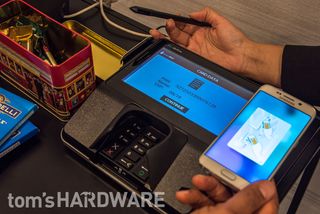
By the time these devices launch, Samsung Pay should (finally) be active as well. Originally included with the Galaxy S6 and S6 edge, Samsung Pay can use either NFC or traditional magnetic stripe terminals, thanks to the Magnetic Secure Transmission (MST) technology it acquired from LoopPay. Samsung Pay has gone through several stages of refinement, and the company said it's nearly ready for launch. Swiping up from the bottom of the lock screen brings up a list of your saved credit cards, and then a pin or fingerprint activates the card.
MST uses a coil in the phone to generate a pulsed magnetic field that mimics the movement of a credit card's magnetic strip. The upshot of this is that Samsung Pay can be used at any retailer that has a standard credit card reader. As an added layer of security, the phone does not broadcast your credit card number, but instead sends a token to the credit card company's servers to verify against Samsung's encrypted records of your card. The obvious caveat here is that Samsung has to get the major credit card companies to all agree to this system, but it claimed to have all the major companies on board.
Samsung has already started testing the technology in select markets and said that people started using Samsung pay about 30-40 percent of the time in these tests with no instruction or prompting. The commercial availability of Samsung Pay in the U.S. will be in September.
Audio Improvements
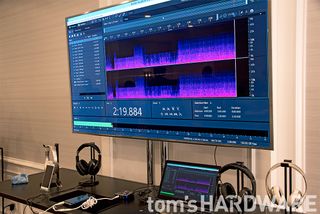
Another new feature Samsung is touting is ultra-high quality audio or UHQA. The idea is that an audio processor built into these phones uses interpolation to upscale audio to a higher bitrate (24-bit 192KHz). Any audio, whether played from the device's memory or from streaming services, could benefit from this conversion. It remains to be seen whether this will actually improve an average user's listening experience (outside of the controlled environment of a PR demo), but there does seem to be some interesting processing going on behind Samsung's tech.
There is also UHQA Bluetooth audio streaming, but this only works with Samsung's "next generation wireless audio accessories." One feature neither phone has is front-facing stereo speakers. This is an oft-requested feature, and if Motorola can incorporate them in the similarly-sized Moto X Style, surely Samsung could too.
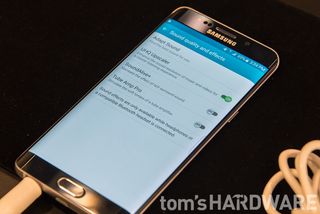
Final Thoughts
The Galaxy S6 edge has proven to be more popular than Samsung expected, with production unable to keep up with demand. Looking to attract even more buyers, the Galaxy S6 edge+ retains the same curved-screen styling, aluminum and glass construction, speedy performance, and long list of features as the S6 edge but should appeal to people who prefer larger phones. The biggest issue we see with this new model is the 64 GB storage limit, which can easily be exceeded when dealing with lots of music, photos and video.
The Note5 seems like a bit of a gamble; you know what they say about fixing things that are not broken. Eliminating the removable battery and microSD card support likely will not sit well with productivity-oriented power users. Removing these features and adopting the same design as the Galaxy S6 also seems to create a lot of overlap with the more mainstream Galaxy S6 edge+. We would have preferred a Note5 that more closely adhered to the Note 4's ethos. We're not saying the Note5 is a bad phone, it's just not what we were expecting.
The Galaxy Note5 will be available in the U.S. with 32 GB or 64 GB of storage in Black Sapphire and White Pearl. The Galaxy S6 edge+ has the same storage choices and will come in either Black Sapphire or Gold Platinum. Both phones will be carried by AT&T, Sprint, T-Mobile, U.S. Cellular and Verizon Wireless. Pricing and availability is still TBA.
Update, 8/13/15, 3:05 pm PT:At today’s Unpacked event, Samsung announced the release date of the Galaxy Note5 and Galaxy S6 edge+ in the US and Canada. It will be available very soon, on August 21. You can also pre-order it in the U.S. from AT&T, Best Buy, Sprint, T-Mobile and Verizon starting today.
In Canada, Telus is the first carrier to confirm that it is carrying both devices. One should also expect to see the Note5 and S6 edge+ available from all the major Canadian carriers such as Bell, Rogers, Wind and Videotron.
Samsung did not announce pricing at today’s event, but when you pre-order it, the 32 GB Note5 is $250 with a 2-year contract, and the 64 GB model is $350. The 32 GB edge+ is $350, and the 64 GB is $450 (!) on a contract. Outright, the Note5 starts at around $700 for the 32 GB model and $800 for the 64 GB, depending on what carrier you choose. The S6 edge+’s outright prices are even higher, at around $800 and $900 for the 32 GB and 64 GB models, respectively.
Pricing for Canada is still not available, but with the weakness of the Canadian Dollar, they should be considerably higher than the U.S. prices.
Samsung also elaborated on a few new features of the phones at the event. Both models have a new “Video Digital Imaging Stabilization” feature that works with the OIS for even smoother videos. They also both support wireless FAST charging, which uses the new 15-watt Qi fast charging standard. Samsung claimed it can fully charge a phone wirelessly in two hours.
-
g-unit1111 I like my Galaxy S6 and it's great to see the design carry over to the Note 5, but for a phone that big to have no SD card - no sale.Reply -
3ogdy Of course the S6 Edge is popular. What did they expect it to be? They did absolutely nothing to their smartphones design-wise since the jump from S2 to S3. They kept re-releasing the refined S3 as S4, S5, S6...it was about damn time they did something to their phones. That's the Edge. They finally innovated their phone design. The S6 Edge is expensive but if I were to buy a phone that would probably be my first choice.Reply
Non-removable batteries and lack of expandable storage are serious issues though. Taking them out of a modern phone is equivalent of going backwards, NOT forward. This is the sort of decision-making that drives customers away. Same idiotic decisions as in many of Microsoft's cases. Same <mod edit> thinking.
Watch the language. - G -
tburns1 Sometimes, my Note 2 just locks the <mod edit> up! Removing the battery has been the only way to recover. What now? I can get over no microSD slot, but this?!? I dunno. What do people do when a phone without a removable battery just locks up and wont shut down?Reply
Watch the language. - G -
roscoe303 Doesn't make sense that they would only do 32/64 variants for there latest Note when the Note 4 can have up to a 128GB with microSD. Probably should have gone 64/128 if there were only going to be two variants, at least for there Note series anywayReply -
tburns1 So wait, does the Note 5 have an IrLED or not? The wife uses her phone as the TV remote almost exclusively. If I upgrade, I'd want to as well.Reply -
howardp6 As an owner of a Samsung Note 4, I would not buy the Note 5 because of the lost of the removable battery and missing micro SD card slot. The better processor, more memory and the touch fingerprint sensor are nice to have, but non-removable battery is the real killer, since the batteries have a high but limited recharge cycle. So you are forced to buy a new phone.Reply -
jaber2 I can do without the SD card or removable battery, I have a S4 and will get the S6 Edge+ when it is available at my t-mobileReply -
dhvd79a Appears that everything that was attractive about the note series is gone except the s-pen. Note series R.I.P. you are now nothing more than a big S6 with a pen.Reply
Note 2 owner for 3 years, recent owner of a Note 4. So happy I didn't wait for the Note 5. I use both the micro sd and the swappable battery. -
JT11 The build quality on these Samsung phones are second to none. We can bicker all we want on SD and Battery Swaps but hey, to each their own.Reply
Most Popular



